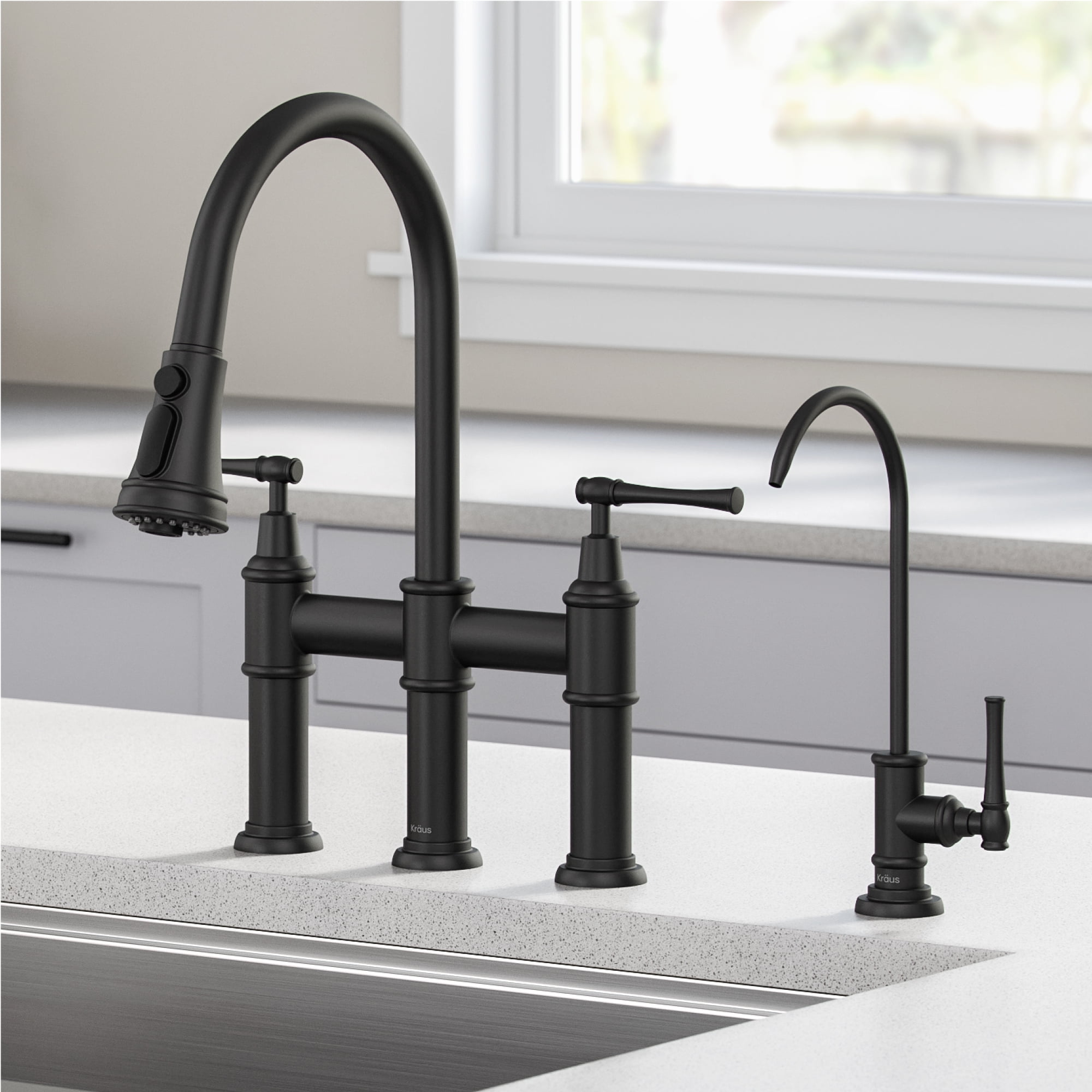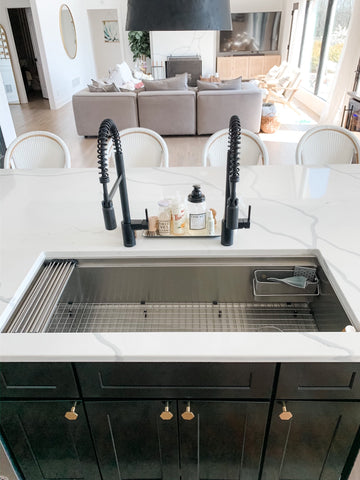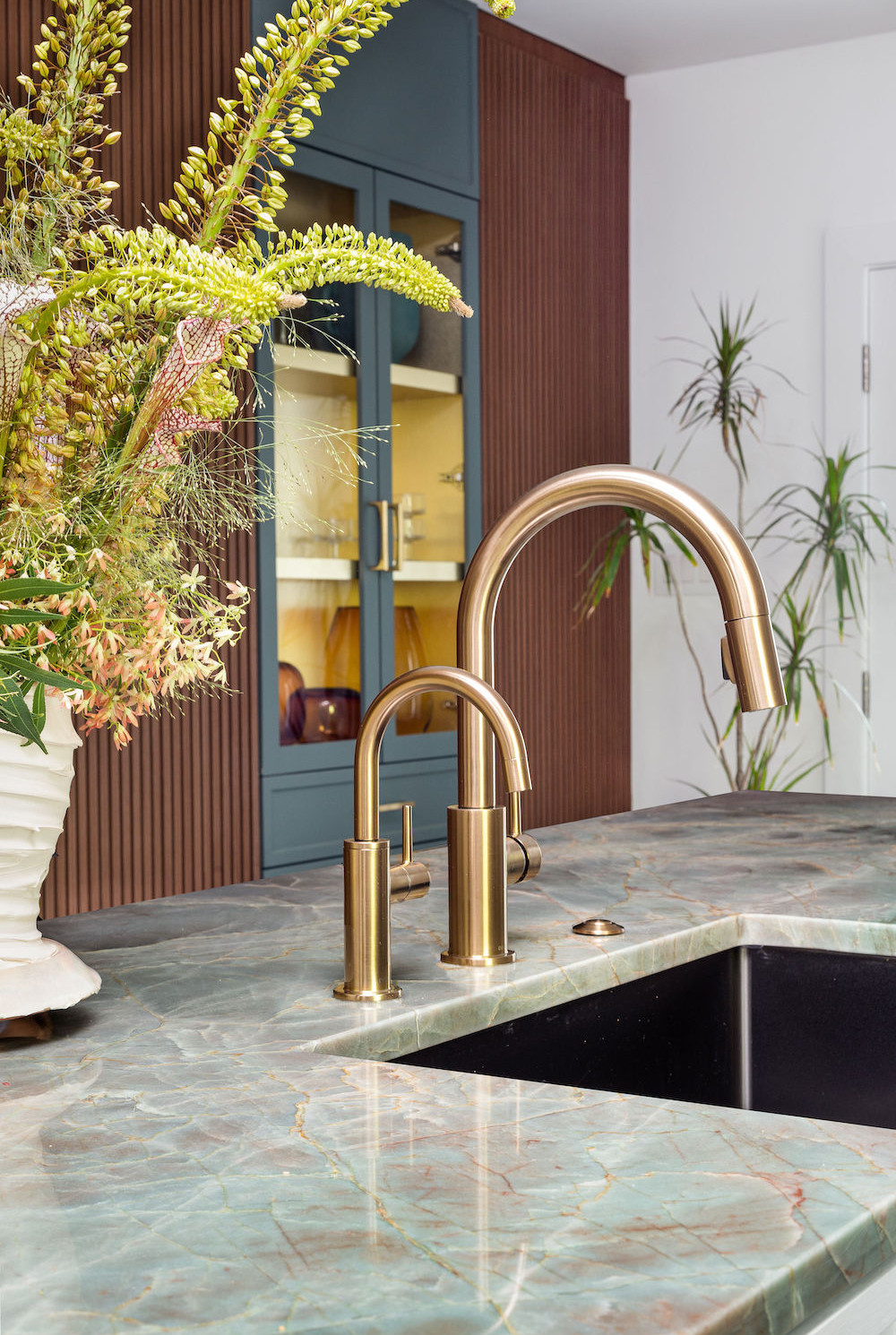A dual faucet kitchen sink is a versatile and functional upgrade that can significantly enhance the efficiency and aesthetics of your kitchen. Unlike traditional single-faucet setups, a dual faucet system incorporates two separate faucets, often catering to different functions. This setup can include one standard faucet for general use and a second faucet dedicated to specific tasks, such as filtered water, instant hot water, or a pot filler. The dual faucet arrangement can streamline various kitchen tasks, making food preparation and cleanup more convenient while also adding a stylish and modern touch to your space.
One of the primary benefits of a dual faucet kitchen sink is the ability to multitask more efficiently. For instance, while one faucet is used for washing dishes or rinsing vegetables, the other can be utilized for filling pots with filtered water or drawing hot water for cooking. This separation of functions allows multiple users to work in the kitchen simultaneously without interference, which is particularly beneficial in busy households or when entertaining guests. The ability to have dedicated faucets for specific tasks also reduces the need to switch between different water functions on a single faucet, saving time and effort.

Another advantage of dual faucets is the ability to integrate specialized water systems directly into your kitchen sink. For example, one faucet can be connected to a water filtration system, providing clean, filtered drinking water without the need for a separate countertop filter or bottled water. This not only improves the quality of the water but also reduces plastic waste and the ongoing cost of purchasing bottled water. Similarly, an instant hot water faucet can provide near-boiling water on demand, which is ideal for making tea, coffee, or quick meals like instant noodles or oatmeal.
The design flexibility offered by dual faucet setups is another compelling reason to consider this upgrade. Homeowners can choose from a wide range of faucet styles, finishes, and configurations to complement the overall design of their kitchen. Whether you prefer a modern, minimalist look with sleek stainless steel faucets or a more traditional design with polished brass, there are countless options available to match your aesthetic preferences. Additionally, the dual faucet setup can be customized with features like pull-out sprayers, touchless operation, or swivel spouts, adding further convenience and functionality.

In terms of installation, dual faucet systems can be adapted to both single-basin and double-basin sinks. For single-basin sinks, the two faucets are typically installed side by side, with one dedicated to general use and the other to a specialized function. In double-basin sinks, each faucet can be assigned to a specific basin, allowing for even greater versatility. For instance, one basin and faucet can be reserved for washing dishes, while the other is used exclusively for food preparation. This separation not only enhances efficiency but also helps prevent cross-contamination in the kitchen.
A dual faucet kitchen sink can also contribute to energy efficiency in your home. By installing a faucet with a dedicated water heater, you can avoid running the main hot water supply just to get a small amount of hot water, which can save energy and reduce your utility bills. Some dual faucet setups even include energy-efficient features like flow restrictors or touchless technology, which minimizes water wastage. These eco-friendly options make the dual faucet system not only a practical choice but also a sustainable one.

For families with children, a dual faucet kitchen sink can be particularly useful. One faucet can be set to provide cold or lukewarm water for tasks like handwashing or filling water bottles, while the other can be used for adult-oriented tasks like cooking or cleaning. This separation ensures that children can safely use the sink without accidentally accessing very hot water. Additionally, dual faucets with touchless technology can make it easier for children to use the sink independently, promoting good hygiene habits.
The installation process for a dual faucet kitchen sink does require some careful planning, especially when it comes to plumbing and countertop space. It’s important to ensure that your existing plumbing setup can accommodate two separate faucets, which may involve additional piping or modifications to your current system. You’ll also need to consider the amount of space available on your countertop or sink deck, as dual faucets will require more room than a single faucet. Working with a professional plumber or kitchen designer can help ensure that the installation is done correctly and that the faucets are positioned for optimal functionality.
Maintenance of a dual faucet kitchen sink is generally straightforward, but it’s important to follow the manufacturer’s guidelines for each faucet type. For instance, a filtered water faucet may require regular replacement of the filter cartridge to ensure the water quality remains high. Similarly, an instant hot water faucet may need periodic descaling to prevent mineral buildup. Regular cleaning of the faucets, especially around the base where water can accumulate, will help prevent corrosion and maintain the finish. By keeping up with these maintenance tasks, you can ensure that your dual faucet system remains in good working order for years to come.
When selecting a dual faucet system, it’s essential to consider the overall design and functionality of your kitchen. Think about how you use your kitchen daily and what tasks you perform most frequently. For example, if you often cook with large pots, a dual faucet setup with a high-arc pot filler might be particularly useful. If you’re focused on water quality, a filtered water faucet could be the right choice. By tailoring the dual faucet system to your specific needs, you can create a kitchen that is both beautiful and highly functional.

The cost of installing a dual faucet kitchen sink can vary depending on the types of faucets you choose and the complexity of the installation. High-end faucets with advanced features like touchless operation or built-in water filtration will naturally be more expensive than basic models. Additionally, if your kitchen requires significant plumbing modifications to accommodate the dual faucet setup, this can increase the overall cost. However, many homeowners find that the long-term benefits of added convenience, efficiency, and style make the investment worthwhile.
In addition to functionality, dual faucet kitchen sinks can also add value to your home. Kitchens are one of the most important areas of a home when it comes to resale value, and modern, well-equipped kitchens are highly desirable to potential buyers. A dual faucet setup can be a unique selling point, demonstrating that the kitchen is both stylish and practical. Even if you’re not planning to sell your home in the near future, the enhanced functionality and aesthetic appeal of a dual faucet system can increase your enjoyment of the space.
Safety is another important consideration when installing a dual faucet kitchen sink. For homes with small children or elderly residents, it’s crucial to ensure that the hot water faucet is equipped with a safety feature to prevent accidental burns. Some faucets come with built-in temperature controls or child safety locks to address this concern. Additionally, placing the hot water faucet in a less accessible position can reduce the risk of accidental usage. By considering safety in your design, you can create a kitchen that is not only functional but also safe for all users.
Lastly, a dual faucet kitchen sink can enhance the overall aesthetic of your kitchen by providing a balanced and symmetrical look. When both faucets are selected in complementary styles and finishes, they can create a cohesive design element that ties the kitchen together. Whether your kitchen style is contemporary, traditional, or transitional, there are dual faucet options available to suit your design vision. The key is to select faucets that not only meet your practical needs but also contribute to the overall look and feel of your kitchen.

Common Mistakes to Avoid
One common mistake when installing a dual faucet kitchen sink is underestimating the space required for two faucets. It’s crucial to ensure that your sink deck or countertop has enough room to accommodate both faucets without overcrowding.
Another mistake is not coordinating the faucet styles and finishes, which can result in a mismatched and disjointed appearance. It’s important to select faucets that complement each other and the overall kitchen design.
Additionally, failing to consider the plumbing requirements can lead to complications during installation. Dual faucets often require additional plumbing, and not accounting for this in advance can result in higher costs and delays.
Overlooking maintenance requirements, such as filter changes for a filtered water faucet or descaling for an instant hot water faucet, can also lead to performance issues down the line. Lastly, neglecting safety features, especially for hot water faucets, can pose a risk, particularly in homes with children or elderly residents.

What are the benefits of a dual faucet kitchen sink?
A dual faucet kitchen sink offers several benefits, including increased efficiency, versatility, and convenience. With two faucets, you can perform multiple tasks simultaneously, such as washing dishes with one faucet while filling a pot with filtered water from the other. Dual faucets also allow you to incorporate specialized water systems, like instant hot water or filtered water, directly into your sink setup. This arrangement can save time and reduce the need for additional kitchen appliances.
How much space do I need for a dual faucet kitchen sink?
The space required for a dual faucet kitchen sink depends on the size and configuration of your sink and countertop. Generally, you’ll need enough room on the sink deck or countertop to accommodate two faucet bases without overcrowding. It’s important to ensure that there’s enough space between the faucets for easy operation and to prevent them from interfering with each other. Consulting with a kitchen designer or plumber can help you determine if your current setup is suitable for a dual faucet installation.
Can I install a dual faucet kitchen sink myself?
While it’s possible to install a dual faucet kitchen sink as a DIY project, it can be challenging, especially if you need to modify your plumbing to accommodate the second faucet. The installation process involves precise measurements, drilling holes for the faucets, and connecting the plumbing. If you’re not experienced with plumbing or kitchen renovations, it’s advisable to hire a professional to ensure the installation is done correctly and to avoid potential issues such as leaks or improper alignment.

What types of faucets work well in a dual faucet setup?
In a dual faucet setup, it’s important to choose faucets that complement each other in terms of style and function. Common combinations include a standard faucet paired with a filtered water faucet, an instant hot water faucet, or a pot filler. The key is to select faucets that meet your specific needs while also creating a cohesive look. Additionally, consider features like pull-out sprayers, touchless operation, and high-arc spouts for added convenience and versatility.
Are dual faucet kitchen sinks more expensive to install?
The cost of installing a dual faucet kitchen sink can be higher than a single faucet due to the additional faucets and potential plumbing modifications required. High-end faucets with advanced features like touchless operation or built-in water filtration will also add to the overall cost. However, many homeowners find that the increased functionality, convenience, and aesthetic appeal justify the investment. The final cost will depend on the types of faucets you choose and the complexity of the installation.
How do I maintain a dual faucet kitchen sink?
Maintaining a dual faucet kitchen sink involves regular cleaning and following the manufacturer’s guidelines for each faucet type. For example, a filtered water faucet may require periodic filter changes, while an instant hot water faucet might need descaling to prevent mineral buildup. Regularly clean the faucet bases and handles to prevent corrosion and maintain the finish. By keeping up with these maintenance tasks, you can ensure that your dual faucet system remains in good working order and continues to enhance your kitchen’s functionality and style.

Related Posts:
- Delta Kitchen Faucet Diverter Assembly
- Low Flow Faucet Aerator Kitchen
- Gold Tone Kitchen Faucet
- Glacier Bay Single Handle Pull Out Sprayer Kitchen Faucet
- Professional Kitchen Faucets Home
- Pfister Kitchen Faucet Replacement Head
- Polished Nickel Bridge Kitchen Faucet
- Single Lever Kitchen Faucet Repair
- Mobile Home Kitchen Sinks And Faucets
- U Bracket Kitchen Faucet